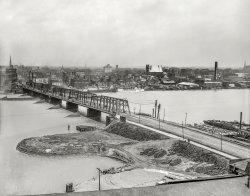
MAY CONTAIN NUTS

Search Shorpy
SHORPY ART

Framed or unframed, desk size to sofa size, printed by us in Arizona and Alabama since 2007. Explore now.
Join and Share
Ad-Free Shorpy
Shorpy is funded by you. Patreon contributors get an ad-free experience.
Learn more.

Recent comments
- Side Winder
- Air Quality?
- Sojourner Truth riot
- None were so blind(ed)
- The less famous sister
- Good ol' days?
- Rise and Fall
- Goo Goo Ga Joob
- Ticket Retention
- Not the only one
- Vagaries of War
- Killed by Amtrak
- Back to the Future
- Wanted --
- If you can't stand the light
- Centralized Traffic Control, I believe
- What's really happening
- Heckuva remote control!
- Sometimes — Things Go Bump!
- I SEE THE LIGHT
- Union Switch and Signal Company
- Get That Light Out Of My Eyes
- Eggs. Eggs. Eggs. The Egg Man is Here!
- Foreboding caption
- Famous Hollywood faces
- Not just S&P
- re: Those things in the jar
- Up In Smoke
- Medical Smoking
- Quick fix
Member Photos
The Shorpy
Print Emporium
Print Emporium
Search Shorpy
Search results -- 30 results per page
- Chicks Ahoy: 1927
- ... I would rather walk the plank than join those ladies in a boat ride. Their eyes look like they've been smokin' left-handed cigarettes. ... Posted by Dave - 09/11/2011 - 1:27pm -
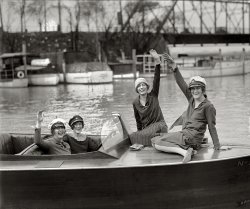
- The Drifter: 1912
- ... Canby, but otherwise just floated along, with the supply boat tied to ours. Best 110 mile long river trek I have ever done.
Lazy ... Posted by Dave - 12/01/2015 - 11:45am -
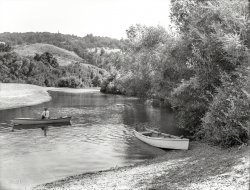
- Summer Idyll: 1899
- ... on the SE corner of Clear Lake just north of the public boat docks right across from Kiesler's campground. It still has a lot of the ... Posted by Dave - 07/10/2017 - 11:33pm -
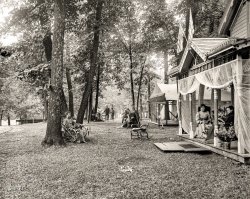
- Two Belles: 1906
- ... It looks like the Belle of Calhoun is a blacks only boat. Can anyone clarify?
"Blacks only"?-"clarify"? ... Posted by Dave - 10/16/2016 - 2:05am -
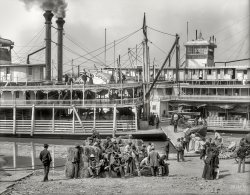
- Johnnie and His Friend: 1908
- ... basic skills...like reading and math. We've missed the boat somehow.
Not wrong, Johnnie! The Not wrong, Johnnie! The Commies ... Posted by Dave - 12/14/2007 - 2:19am -
![Johnnie and His Friend: 1908 Tallest boy Johnnie Younts, 72 Kirk Street, Salisbury, North Carolina. Has worked at in Salisbury Mills for 8 years. Began at 7 years old. When can he get any education? Other boy one year in mill. December 1908. Photograph by Lewis Wickes Hine. View full size. [At least they could afford nice clothes - Dave]
JohnnieI dare say we're educating children for 13+ years now only to discover they don't have the basic skills...like reading and math. We've missed the boat somehow.
Not wrong, Johnnie! TheNot wrong, Johnnie! The Commies said they'd do it.
My grandmother & her sistersMy grandmother & her sisters only went to school to about the 6th grade. One sister was very smart, so she was skipped up a grade in school. My mom says that was about all the education girls were given then (early 1900s) unless they planned to teach school. Usually if you taught school, you only taught until you married or shortly after marriage as schools wouldn't employ a visibly pregnant woman. My grandmother and one sister died before I was born, but I remember her other sister Essie (the smart one) who could read and write as well as anyone I know.
(The Gallery, Lewis Hine, Railroads)](https://www.shorpy.com/files/images/01514u_0_0.thumbnail.jpg)
- Broad Ripple: 1907
- ... and also perhaps for sliding heavier items down to the boat instead of carrying down the stairs. Just a guess.
Remembering Broad ... Posted by Dave - 06/09/2013 - 9:56am -
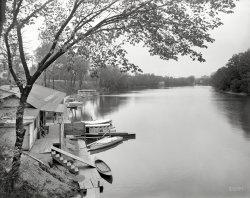
- Wilson Dam: 1942
- ... this page. (Look for the third Cape Girardeau , the boat’s original name.)
(The Gallery, Arthur Rothstein, Boats & Bridges) ... Posted by Dave - 08/03/2012 - 11:35am -
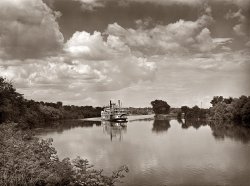
- Let's Take the Ferry: 1951
- ... oldest ferry still operating in Florida.
This ferry boat consists of a 1914 steel barge, propelled by a converted 1910 Sharpie ... Posted by fixj - 09/06/2015 - 4:13pm -
![Let's Take the Ferry: 1951 One of our annual trips from New Jersey to Florida circa 1951-52. This was pre-Interstate days and we traveled U.S. 17, 301 or sometimes A1A. Not sure which ferry this is. With Mom, sister and older brother. View full size.
Nanticoke River at Seaford, Delaware?The Woodland Ferry lies on a possible route between New Jersey and Florida via Delaware, Maryland, and Virginia. It is a cable ferry. Here is a link to photo of the 1938 version that was replaced about 1961. The chain does not show in the Shorpy photo but might be explained by photographer standing with back to cable and operator shack. A second ferry ride awaits our travelers when they reach the Chesapeake Bay.
My family took the Chesapeake ferry ride in 1947 when we traveled from Jacksonville, Florida to visit my aunt in Trenton, New Jersey. I remember the Chesapeake crossing because my four year old brother and I held our three year old brother over the railing so he could see the water.
http://capegazette.villagesoup.com/media/Common/0/5B/23510/t600-pg_7_pic...
Looks Like The Fort Gates FerryAnd it's still in service today. This is almost certainly the Ft. Gates Ferry which has been operating since the 1850s, crossing the St. Johns River south of Palatka, Florida, north of Lake George, between the Fort Gates Fish Camp and Salt Springs in the Ocala National Forest. It is the oldest ferry still operating in Florida.
This ferry boat consists of a 1914 steel barge, propelled by a converted 1910 Sharpie sailboat that is permanently connected to the barge.
The last time we took it the toll was $10, well worth it.
[It certainly seems like a possibility, but how do we know it's the Fort Gates ferry? - Dave]
Not FloridaThe Fort Gates ferry is reached by 12 miles of dirt road on West and 1 mile of dirt road on East making this an unlikely route for a vacationing family. The ferry in the photo has a deck mounted air vent suggesting an on board engine. The built up area on the shore is also questionable.
The ferry Jean LaFitte at the Mayport crossing of the St. Johns River in the 1950s was a much larger vessel with enclosed deck. The vessel in the photo is no match for currents running at mouth of the St Johns River.
I grew up in Jacksonville, and as much as it pains me, I vote against Fort Gates.
Chilly WeatherJudging from the winter hats and coats being worn, my guess might be that the location is somewhere to the north of Florida.
(ShorpyBlog, Member Gallery)](https://www.shorpy.com/files/images/dDorothy_Judi_Jack_Jim_on_ferry_boat.thumbnail.jpg)
- Bread and Coffee: 1909
- ... first municipal lodging house fitted up by the city was a boat moored at the foot of East 26th Street in 1895, followed a few years after ... Posted by Dave - 09/09/2011 - 2:21pm -
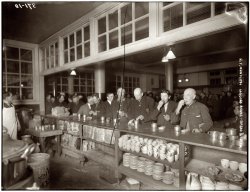
- Owana at Toledo: 1912
- ... , 1884.
Sidewheeler Frank E. Kirby , 1890.
Fire boat James Battle , 1900.
Steamship Tionesta , 1900.
... Posted by Dave - 10/29/2012 - 10:42pm -
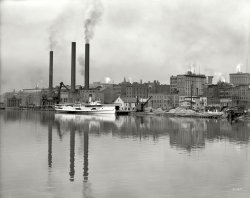
- Canoemobile: 1902
- ... Very hybrid What's being hauled is an Adirondack guide boat, itself a hybrid - not a canoe, not a rowboat, but the best of both. It's ... Posted by Dave - 08/09/2012 - 6:48pm -
![Canoemobile: 1902 The Adirondack Mountains, New York, circa 1902. "An Adirondack hand cart carry." Yet another example of hybrid transportation. 8x10 inch glass negative by William Henry Jackson, Detroit Publishing Company. View full size.
Tree on the Left of FrameWhat's with the tree on the left it appears to have its bark peeled away in several bands. One at its base somewhat large, then two smaller above that one both about the same size, then one much larger above those.
[Horizontal peeling is typical of the white and paper birch. -tterrace]
Very hybridWhat's being hauled is an Adirondack guide boat, itself a hybrid - not a canoe, not a rowboat, but the best of both. It's been around since the early 19th century. In the photo, it's probably moving between lakes or ponds over a "carry," many of which connect the Fulton Chain of Lakes in the eastern side of the Adirondacks.
I did this For two or three summers, I did portage, or haulage as you will, humpin' anything the camper couldn't or wouldn't. Skiffs, dorys, canoes and home built, though they were some heavy clunkers, I wanted to lecture them on the virtues of birch and cedar over oak and hemlock. But at the end of most trips, I must say they all tried to shoulder out their craft. I miss them, because now I camp alone on Benson Lake.
TreesWhite birch = paper birch.
Both are common names for Betula papyrifera
(The Gallery, Boats & Bridges, DPC, W.H. Jackson)](https://www.shorpy.com/files/images/SHORPY_4a09900a.thumbnail.jpg)
- Time and Tide: 1915
- ... looks to have put down his cane in the foc's'cle of the boat.
[Right-shin guy's "bandage" is a splash. - tterrace]
(The ... Posted by Dave - 01/05/2015 - 2:44pm -
![Time and Tide: 1915 The Jersey Shore circa 1915. "Atlantic City bathers and Steel Pier." 5x7 inch dry plate glass negative, Detroit Publishing Company. View full size.
Bathing suit evolutionI was surprised that this one wasn't sooner than 1920, because of the fact that the bathing suits still looked like 10-15 years earlier while, just a couple years later, they were wearing the wool sleeveless suits that exposed most of the thigh. I wonder if it was regional, in part, that the skimpier suits started farther south and worked their way farther north. A few of them in this photo have shorter sleeves, but most still look like they are wearing the lighter corsettes under them. The wool suits, scratchy as they sound, would have been quite liberating over all the layers and layers. I just had another thought, though. When they got wet, they would have made the girl smell like a wet sheep!
Walking Wounded?Three fellows caught my eye: one has a bandage on his left shoulder, one has a bandage on his right shin, the other looks to have put down his cane in the foc's'cle of the boat.
[Right-shin guy's "bandage" is a splash. - tterrace]
(The Gallery, Atlantic City, DPC, Swimming)](https://www.shorpy.com/files/images/SHORPY_4a27536a.thumbnail.jpg)
- Stinson 10A: 1943
- ... day his engine quit at sea and he was later picked up by a boat. After the war, one of the German sub commanders responded that it was ... Posted by Dave - 12/10/2007 - 6:13am -
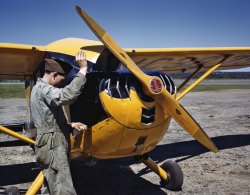
- The Good Old Summertime: 1910
- ... their rescues. They still use them today. You can see the boat on the horizon.
Thanks Dave Through your website, you have given us ... Posted by Dave - 04/27/2015 - 9:08am -
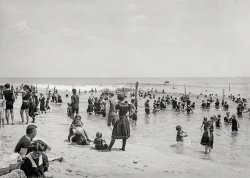
- Open and Shut: 1921
- ... the building.
"Pram" could be derived from the small boat of the same name, or it might be a truncation of "perambulator"
My ... Posted by Dave - 01/31/2017 - 10:58am -
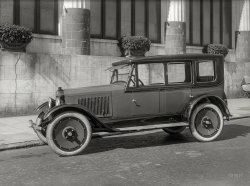
- More Manhanset: 1904
- ... position of all the flags, as well as the idle sail of the boat, the wind was moving from left to right. So, the smoke or steam likely ... Posted by Dave - 02/24/2019 - 1:29pm -
![More Manhanset: 1904 Shelter Island, New York, circa 1904. "Landing at Manhanset Manor." The sidewheeler Nantasket coming abeam. 8x10 inch glass negative. View full size.
Re: Steam or SmokeJudging from the position of all the flags, as well as the idle sail of the boat, the wind was moving from left to right. So, the smoke or steam likely came from the far (left) side of the dock.
The machine at the left edge of the photo could be some sort of pile driver, though I could find nothing resembling it on the web. The poles and lumber lying on the pier may have been part of a maintenance effort. If this machine was steam-driven, then it's possible it was the source of the smoke.
[That's a ferry landing; the "pile drivers" are counterweights for ramp. - Dave]
Steam? Or sea spray?What is the steam or sea spray at the bottom left third? The water looks fairly calm, so I'm presuming it's steam, but from where?
Airing OutNot very often these days do we see a vessel (in this case a gaff-rigged catboat) left in its slip with its sails still hoisted. But, until the advent of modern synthetic fabrics, leaving sails aloft for awhile was commonly practiced in order to dry the heavy cotton canvas from which they were made. Moisture-induced mildew, rot, and rust were a constant plague in the days of wooden ships and iron men.
Item of Interest to the Shelter Island Colony Brooklyn Life (Brooklyn, New York) 30 Oct 1915, Sat • Page 25
SmokeWhat do you think is causing the big cloud of smoke at the shore end of the pier? It looks like it is coming from underneath the water. When did this pier (as everything else of the era) burn down?
(The Gallery, Boats & Bridges, DPC, Small Towns)](https://www.shorpy.com/files/images/SHORPY-4a11420a.thumbnail.jpg)
- City of Ottawa: 1907
- ... at Union Dry Dock, Buffalo Shipbuilding.
I suspect the boat may have been named for Pennsylvania congressman William Lawrence Scott ... Posted by Dave - 01/22/2018 - 11:21pm -
![City of Ottawa: 1907 Cleveland circa 1907. "Steamer City of Ottawa entering Cuyahoga Creek." 8x10 inch dry plate glass negative, Detroit Publishing Company. View full size.
What is supporting that bridge?Was this photo somehow manipulated or am I just not seeing the bridge/ferry landing properly? The shadows do not look correct, nor does the water beneath it. Is the dark pile which is barely visible made of steel, and all that is bearing the weight?
[It's a swing bridge in the open position. -tterrace]
Thanks Dave...makes perfect sense now! I hadn't considered that it was pointing 90 degrees from its normal orientation :-) (even though I have a defunct center pivot one close by)
The Name GameCity of Ottawa had a pretty long life on the lakes, a nearly went further. Christened the INDIA in 1871, she joined sister ships in service known as CHINA and the JAPAN. From the annals of the Toronto Maritime Society, these were no run of the mill steamers plying the Great Lakes.
"...The passenger cabin of each was a veritable palace compared to other ships then operating. The staterooms opened off a long open passageway in which the dining tables were set at mealtimes. At the forward end of the cabin was the men's smoking room, while at the after end of the passenger area the cabin opened out into a spacious and luxuriously appointed ladies' cabin, complete with grand piano. The woodwork up to the level of the clerestory was varnished, while the deckhead was painted white. Woodcarvings were in evidence everywhere. The entire cabin was fitted with carpeting and an elegant companionway led down to the main deck where the purser's office was located. As usual for the period, bathroom facilities were not provided in the staterooms but each room did boast "running water" in that reservoirs mounted over the sinks were filled daily by the stewardesses and after that gravity did the rest. The galley was located on the main deck and the food (of excellent repute) was brought to the cabin by means of a primitive lift."
Ironically, while she went by City of Ottawa renaming for most of her sailing days, the ship started as INDIA and ended that way as well, while being refitted for saltwater use during WWII. She was sent down the Mississippi River to New Orleans but deemed too old and unfit, was eventually laid up along Lake Ponchartrain, where it's believed she meet her end to scrappers in 1945.
Launched on June 20, 1871 at Buffalofor the Atlantic, Duluth & Pacific Company by Gibson & Craig and the King Iron Works, the India was the first of a trio of state-of-the-art iron passenger and freight vessels running between Buffalo and Duluth, the others the China and Japan. Beginning the next year and for the next decade it ran for the Lake Superior Transit Company, allied with a pool of railroad-related steamship companies and after that with the Anchor Line, part of the Pennsylvania Rail Road. Sold in 1906 to the Montreal & Lake Erie Steamship Company, reflagged Canadian, repowered, and renamed the City of Ottawa, the vessel operated as the firm's name implies. Its passenger accommodations were removed in 1913 when Canada Steamship Lines Ltd. acquired the vessel and placed it in the package freight trade between Hamilton and Montreal. Laid up in 1926, the City of Ottawa was sold back into American registry briefly in 1928 and renamed India, and the next year back into Canadian registry for the Algoma Central Railway Company and renamed Sault Ste. Marie, running between Fort William and Toronto. In 1930 it again entered American registry and reverted again to the name India, cut down to a coal barge. Requisitioned by the Maritime Commission for war service in 1942, the India was brought down the Chicago River, Sanitary and Ship Canal, and the Illinois and Mississippi Rivers for a conversion that never occurred. The India was dismantled on the shore of Lake Pontchartrain in 1945.
The William L. Scott was built at Buffalo in 1890 by the Union Dry Dock Company for that city's Hand & Johnson Tug Line. It was abandoned and dismantled in 1915, probably at Erie, Pennsylvania.
Swing bridge?Never was a real fan of bridges that move. Really like them sitting still and anchored.
Getting A LiftFor fans and non-fans of moving bridges, the current edition at or near that same spot is a rather impressive rail lift bridge, rather than swing version. Everything's up to date in Cleveland.
Tugging at your heartThe tug WILLIAM L. SCOTT, built in 1890, was steam powered and of wood construction, weighing 54 gross tons, with dimensions of 67.9 x 17.4 x 10 feet. It was dismantled in 1915 at Union Dry Dock, Buffalo Shipbuilding.
I suspect the boat may have been named for Pennsylvania congressman William Lawrence Scott (1828-1891).
(The Gallery, Boats & Bridges, DPC)](https://www.shorpy.com/files/images/SHORPY-4a25406a.thumbnail.jpg)
- Ontario in the Ice: 1905
- ... Tracks, we don't need no stinkin' tracks, we're using a boat !
Now they've done it They cracked the Lake!
Vintagetvs ... Posted by Dave - 08/15/2012 - 3:06pm -
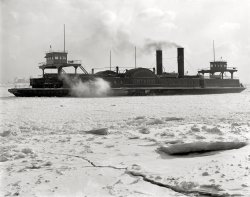
- Palm Walk: 1897
- ... door-to-door salespeople. At least the ones arriving by boat.
Don't Sit Under the Apple Tree And don't sit under the ... Posted by Dave - 04/28/2018 - 1:25pm -
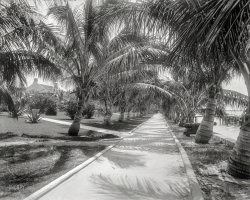
- Passing Through: 1915
- ... west chamber, Panama Canal." Just the thing to float your boat. 8x10 inch dry plate glass negative. View full size.
Canal Zone ... Posted by Dave - 08/18/2014 - 7:20pm -
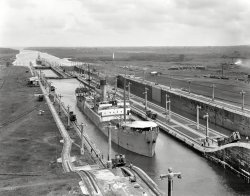
- Bi-Biplane: 1917
- ... was a complete failure. The machine veered off the boat into the river, almost drowning the pilot, a fellow named Manley. A few ... Posted by Dave - 10/01/2013 - 5:48pm -
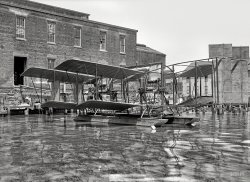
- For Faster Service
- ... - a travelling merchandiser. Can you spot the River Boat Kit? View full size.
Riverboat That was a TV series from 1959 ... Posted by drm - 06/08/2012 - 10:26pm -
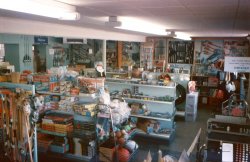
- Central High Shell: 1927
- ... is generally credited to John C. Babcock of the Nassau Boat Club in New York, who used them on a single in 1857 and on a six-oar in ... Posted by Dave - 09/03/2012 - 9:44am -
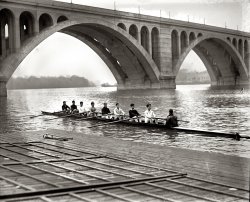
- Self-Contained: 1939
- ... recall feeling deprived. Most people were in the same boat.
(The Gallery, Cats, Dogs, Russell Lee) ... Posted by Dave - 05/23/2018 - 2:46pm -
![Self-Contained: 1939 March 1939. "Home of fisherman squatter on shores of Nueces Bay. Corpus Christi, Texas. Photographs show squatters and migrants in shanty town along Nueces Bay area. Tents, shelters constructed from old boats, tar paper, automobile licenses, boxes. Privy made of automobile body." Medium format negative by Russell Lee for the Farm Security Administration. View full size.
Kitten finds fantasy living arrangementThat cat on the doorstep must know that he will have fish and seafood aplenty as long as he sticks around with fishermen squatters and he is not planning to leave this location. How lucky can one cat get?
It was worse than we knowMy father (1907-1983) often said that I or my children could never imagine the hunger, squalor and hopelessness of the Great Depression.
Kitten!There has never ever been a building or a place around fishing that didn’t have a cat or two. And these people, though poor, at least kept the area around their shack swept and picked up.
[There's also a big dog. - Dave]
ForagingOne thing I remember during the depression is foraging for extra food. We'd pick dandelions to be had for greens. Not too bad, as I remember. My dad had no job til about 1939, so we lived a while with my grandmother, and later out west on my aunt and uncles ranch. At least we wern't relegated to a shack. I don't recall feeling deprived. Most people were in the same boat.
(The Gallery, Cats, Dogs, Russell Lee)](https://www.shorpy.com/files/images/SHORPY-8b21017a.thumbnail.jpg)
- Flame War: 1905
- ... it was quite a spectacle: "Fall of Pompeii", "Submarine Boat", "Midget City, 300 Lilliputians", "Peter F. Dailey, A Paris Novelty" -- ... Posted by Dave - 02/10/2015 - 10:51am -
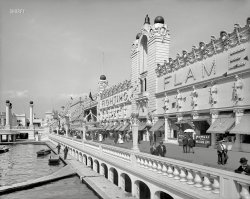
- "Silhouette on the Sassafras 1950
- ... Corp. in Camden, New Jersey. This was the third boat he built for personal use. The other two were wooden Class sloops: "Patsy ... and finally sold her in 1962. The couple who purchased the boat cruised the East coast, the Caribbean, Central and South America, ... Posted by microanne - 03/07/2011 - 10:15am -
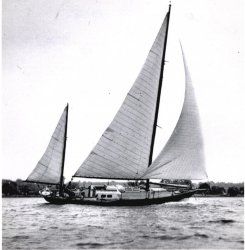
- Boats-n-Buggies: 1940
- April 1940. "Abandoned boat along Mississippi River waterfront. Dubuque, Iowa." Photobomb by the A.A. ... Posted by Dave - 11/23/2019 - 5:11pm -
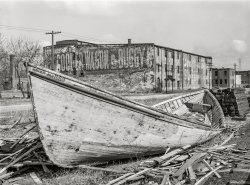
- Fireboat 44: 1905
- ... here and renamed in 1923 the MV Angus J. McDonald. That boat was replaced in 1931 and the company disbanded in 1954.
Brave men ... Posted by Dave - 05/08/2018 - 6:58pm -
![Fireboat 44: 1905 Boston circa 1905. "Fireboat, Engine No. 44." 8x10 inch dry plate glass negative, Detroit Photographic Company. View full size.
Tall ShipsInteresting to see so many wind-powered ships in the background- some steam assisted ones too.
Ten years after this photo, every ship, no matter what its propulsion, was being pressed into service because of the pressures of WW1. Seeing so many sailing vessels still active in 1905 helps one to understand how there happened to be lots of sail powered ones available for service through the war.
1895-1954Sept. 1, 1895 – Fireboat Company 44 was organized on the south side of India Wharf, off Atlantic Avenue, downtown, at a berth formerly used by fireboat Engine Company 31. The company was assigned a new fireboat, seen here and renamed in 1923 the MV Angus J. McDonald. That boat was replaced in 1931 and the company disbanded in 1954.
Brave menThe fireboat appears to be made of wood. Brave to come up to burning ships in such a vessel, to put it mildly.
[That's not what fireboats are for. They fight fires in the warehouses and docks along the waterfront. - Dave]
Interesting as well to see no smoke coming out of the funnel, but the ship is leaving a wake. I wonder what she's burning--either a coal fire is burning down in the firebox, or could it be an early adopter of fuel oil?
In which case the men are doubly brave, I dare say.
(The Gallery, Boats & Bridges, Boston, DPC, Fires, Floods etc.)](https://www.shorpy.com/files/images/SHORPY-4a11412a.thumbnail.jpg)
- Her First Kissel: 1922
- ... the Chrysler outboard motor operation and the Bayliner boat company, among other enterprises. Could that be the understudy’s scarf ... Posted by Dave - 11/11/2016 - 12:36pm -
![Her First Kissel: 1922 San Francisco circa 1922. "Kissel Tourster at Golden Gate Park." The driver evidently an understudy for Isadora Duncan. 5x7 glass negative. View full size.
Isadora LiteEvidently one must work up gradually to the full-throttle version.
She's a beauty, the car that is, and is presently represented by one surviving example per KisselKar Klub. It’s a 1921 Kissel Model 6-45 Sport Tourster. Kissels were produced in Hartford, Wisconsin and were known for their high quality. The factory building is still with us, having housed the Chrysler outboard motor operation and the Bayliner boat company, among other enterprises. Could that be the understudy’s scarf hanging out the door?
[Hence the gag ... so to speak. -tterrace]
(The Gallery, Cars, Trucks, Buses, Chris Helin, San Francisco)](https://www.shorpy.com/files/images/SHORPY-1058A.thumbnail.jpg)
- Cherry Street Bridge: 1909
- ... cart attending to something going on with that shallow boat by the shore at the bottom of the photograph; and so much more to be ... Posted by Dave - 09/18/2016 - 4:13pm -
